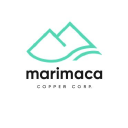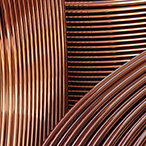Marimaca: Low-Cost Copper Play for 2026 Deficit

Marimaca Copper's $587M project delivers 39% IRR as ICSG forecasts 2026 deficit. Low-cost cathode production meets tightening market. Analysis for investors.
- Marimaca Copper's Definitive Feasibility Study delivers exceptional economics: US $1.1 billion post-tax NPV, 39% IRR, and a 2.2-year payback with competitive US $2.09/lb all-in sustaining costs positioning it in the second quartile globally.
- The project enters development as the International Copper Study Group forecasts a 150,000-ton refined copper deficit in 2026, creating a favorable supply-demand backdrop for new producers bringing low-cost production online.
- With initial capex of just US $587 million and capital intensity of US $11,700 per ton of annual capacity, Marimaca ranks among the lowest-cost copper developments globally, significantly de-risking the path to production.
- The company controls 854,000 tons of measured and indicated copper resources with 93% confidence, supported by 135 kilometers of drilling, and has secured critical infrastructure including recycled seawater supply and renewable power in Chile's established mining region.
- District-scale exploration potential across oxide and sulphide targets at Pampa Medina and Madrugador, located 25 kilometers from the processing plant, offers substantial resource expansion upside beyond the 13-year mine life.
Introduction: Timing Meets Opportunity in Chile's Copper Belt
The copper market stands at an inflection point. While the International Copper Study Group recently downgraded 2025 mine production growth from 2.3% to 1.4% due to disruptions across Indonesia, Chile, and Congo, refined copper demand is projected to grow 2.1% to 28.7 million tons in 2026. This widening gap between constrained supply and rising consumption has prompted ICSG to reverse its earlier surplus forecast, now projecting a deficit of approximately 150,000 metric tons in 2026.
Against this tightening backdrop, Marimaca Copper emerges as a compelling investment proposition. The company completed its Definitive Feasibility Study in 2025 for a project in Northern Chile's Coastal Copper Belt that combines low capital intensity, competitive operating costs, and near-term construction visibility. With copper prices hitting 16-month peaks in response to shortage concerns, developers with de-risked projects and favorable economics stand to capture significant value as the market pivots from surplus to deficit.
Located 25 kilometers from the Port of Mejillones and 40 kilometers from Antofagasta, Marimaca benefits from established infrastructure in one of the world's premier mining jurisdictions. The project targets heap leach processing of oxide copper deposits, a lower-carbon method that reduces emissions by approximately 38% compared to conventional processing while delivering steady-state production of 50,000 tons per annum of copper cathode for a decade.
Company Overview: Pure-Play Copper Developer in Proven Territory
Marimaca Copper operates as a focused copper development company with its flagship project situated in Chile's Coastal Copper Belt near Antofagasta. The company maintains a market capitalization of C$1.3 billion as of September 2025, trading at C$11.56 per share with no debt and US $24 million in cash as of June 2025, excluding an A$80 million capital raise. Strategic shareholders include Greenstone at 22%, Assore at 16%, Ithaki at 14%, and Mitsubishi at 4%, providing both financial backing and technical expertise.
The management team brings proven expertise in project delivery and exploration. CEO Hayden Locke leads the executive team alongside Chairman Michael Haworth, Vice President of Exploration Sergio Rivera, and CFO and Chile Director Jose Merino. This combination of operational experience and local knowledge proves particularly valuable in navigating Chile's regulatory environment and maintaining stakeholder relationships in a region with established mining culture.
The company's strategic positioning in the Coastal Copper Belt places it within proximity to major regional operations. This location provides access to skilled labor, established supply chains, and proven geological potential while government-controlled land holdings reduce permitting complexity compared to projects requiring private land negotiations or community relocations.
Key Development: DFS Economics Beat Global Benchmarks
The 2025 Definitive Feasibility Study demonstrates exceptional project economics that position Marimaca favorably against competing copper developments worldwide. The study calculates a post-tax net present value of US $1.1 billion at an 8% discount rate, with an internal rate of return of 39% based on a copper price assumption of US $5.05 per pound. The 2.2-year payback period ranks among the fastest in the industry for projects of comparable scale.
Capital requirements total US $587 million for initial development, translating to US $11,700 per ton of annual production capacity. This capital intensity compares favorably against competing projects according to industry research. The capital breakdown allocates 38% to heap leach and solvent extraction-electrowinning facilities, 24% to crushing infrastructure, 8% to broader site infrastructure, and 10% to contingency reserves, reflecting a conventional scope with limited technical risk.
Operating economics prove equally compelling with all-in sustaining costs of US $2.09 per pound placing Marimaca in the second quartile of global copper producers. The project targets proven and probable reserves of 178.6 million tons grading 0.42% total copper, containing 748,000 tons of recoverable copper metal. Mining employs conventional truck-and-shovel methods across eight pit phases with a life-of-mine strip ratio of 0.8 to 1, minimizing waste handling costs. Processing through crushing to P80 12.5 millimeters, heap leaching, and electrowinning achieves 72% copper recovery with leach cycles ranging from 62 to 83 days.
Strategic Significance: Green Copper Meets Growing Deficits
The project's environmental profile addresses increasing investor and consumer focus on sustainable copper production. This positioning gains strategic importance as refined copper production growth slows. The ICSG projects just 0.9% growth in refined copper output for 2026 compared to 3.4% in 2025, constrained by limited concentrate supply even as scrap utilization increases. With China representing 58% of global refined copper demand at 16.6 million tons in 2026, and consumption outside China remaining weak across the EU and Japan, new supply must compete on both cost and sustainability credentials.
The company secured a recycled seawater pipeline from Mejillones Bay, eliminating freshwater consumption in water-stressed Northern Chile, while contracted renewable electricity further reduces the carbon footprint. This infrastructure de-risking proves critical as water access has delayed competing projects in arid mining regions globally.
The timing of Marimaca's development cycle aligns with this market transition. The company received the ICSARA environmental permit in February 2025 and is advancing detailed engineering and financing processes through 2025. Long-lead procurement and construction initiation target 2026, positioning first production to enter a market transitioning from surplus to deficit. Annual EBITDA averaging US $326 million with 58% margins provides substantial cash generation capacity, with free cash flow payback projected at 2.5 years post-tax.
Current Activities: De-Risking Path to Production
Marimaca is executing a systematic de-risking program focused on permitting, engineering, and financing workstreams. The February 2025 receipt of the ICSARA permit represents a critical milestone in Chile's environmental approval process, validating the project's technical design and environmental management plans. Parallel detailed engineering work is refining capital and operating cost estimates while identifying optimization opportunities across crushing, leaching, and cathode production circuits.
The company is simultaneously advancing financing discussions to secure the US $587 million initial capex requirement. The strong project economics, with 39% IRR and rapid payback, position Marimaca favorably for debt financing which typically targets projects with post-tax IRRs above 20% and payback periods under five years. The strategic shareholder base including Mitsubishi, a major Japanese trading house and metals consumer, provides potential offtake and project financing pathways beyond traditional mining debt structures.
Exploration activities continue to expand the resource base and define district-scale potential. Active drilling programs target the Pampa Medina and Madrugador areas located approximately 25 kilometers from the planned processing plant. These targets include high-grade oxide and sulphide zones with complementary deposits at Cindy, Mercedes, Tarso, Sierra, and Roble each offering potential for 20 to 40 million tons at grades ranging from 0.2% to 0.4% copper. Recent step-out drilling at Pampa Medina sulphides extending beyond 300 meters depth confirmed open mineralization along strike and at depth, suggesting the current 13-year mine life represents a conservative baseline with significant expansion potential.
Resource Base: Quality & Quantity Support Long-Term Value
The 2025 Mineral Resource Estimate establishes a robust foundation for the project with 213.5 million tons of measured and indicated resources grading 0.40% copper, containing 854,000 tons of copper metal. An additional 21.2 million tons of inferred resources at 0.29% copper add 62,000 tons of potential future inventory. The 93% classification in measured and indicated categories reflects high geological confidence supported by 135 kilometers of drilling, reducing resource conversion risk as the project advances.
Reserve conversion from the resource base demonstrates efficient mining selectivity. The proven and probable reserve of 178.6 million tons at 0.42% copper containing 748,000 tons represents an 88% conversion rate from measured and indicated resources, indicating minimal waste dilution and effective pit optimization. The reserve grade of 0.42% exceeds the resource grade of 0.40%, reflecting selective mining of higher-grade zones in the early mine plan to accelerate payback.
This resource quality becomes particularly significant given current market dynamics. While ICSG forecasts mine output growth of 2.3% in 2026 driven by expansions and recovery in Chile, Peru, Zambia, and Indonesia, production interruptions in 2025 demonstrate ongoing execution risks across the industry. Projects with high-confidence resources in established jurisdictions face lower development risk than those dependent on resource expansion in frontier regions or requiring complex metallurgical processing of lower-grade or refractory ores.
District Potential: Exploration Upside Extends Value Horizon
Beyond the core deposit feeding the initial 13-year mine plan, Marimaca controls a district-scale land position with multiple exploration targets offering resource expansion potential. The Sierra de Medina region hosts regional copper mineralization systems similar to those supporting nearby operating mines. This geological analogy reduces exploration risk while the proximity to existing infrastructure enables rapid development of satellite deposits through toll processing or plant expansions.
The Pampa Medina sulphide target represents the most advanced exploration opportunity. While sulphide ores require different processing than the oxide heap leach operation planned for initial development, sulphide deposits typically support longer-life, higher-tonnage operations. The proximity to port facilities and concentrate shipping infrastructure in Mejillones positions sulphide development as a logical second phase following oxide production.
Complementary oxide targets including Cindy, Mercedes, Tarso, Sierra, and Roble each offer potential resources ranging from 20 to 40 million tons at grades between 0.2% and 0.4% copper. These deposits could extend the heap leach operation beyond the current 13-year mine life through plant capacity expansions or sequential development feeding the existing infrastructure. The planned Phase 2 expansion already incorporates tertiary crushing and additional heap leach cells, providing a blueprint for capacity growth as additional resources convert to reserves.
Investment Thesis for Marimaca Copper
- Enter copper exposure before the projected 2026 deficit drives sustained price increases above current 16-month peaks.
- Prioritize projects with sub-US $600 million capex and sub-three-year paybacks to limit downside in volatile commodity cycles.
- Favor developments with secured water supply, renewable power access, and government land tenure in established mining regions.
- Allocate to producers offering 30%+ carbon reduction versus conventional methods as sustainability premiums emerge.
- Diversify into developers with district-scale exploration upside beyond initial mine plans to capture resource expansion value.
- Select companies with major strategic shareholders and no debt entering construction to weather development execution risks.
Marimaca Copper presents a compelling value proposition for investors seeking leveraged exposure to copper's structural supply-demand imbalance. The combination of low capital intensity at US $11,700 per ton of capacity, competitive AISC of US $2.09 per pound, and rapid 2.2-year payback delivers project economics that rank in the top quartile of global copper developments according to analyst research. These metrics become increasingly important as the ICSG's deficit forecast for 2026 validates the thesis that constrained mine supply cannot keep pace with refined copper demand growth.
Beyond the near-term development opportunity, the district-scale exploration potential at Pampa Medina and surrounding targets offers resource expansion upside that could extend mine life and increase production throughput. For investors, this optionality provides leverage to sustained copper prices while the low-cost production profile protects downside in weaker price environments. The strategic shareholder base including Mitsubishi provides potential offtake support and project financing alternatives beyond traditional debt markets. As the copper market pivots from surplus to deficit through 2026, quality development projects with proven resources, competitive economics, and near-term production timelines stand to capture significant value in a supply-constrained environment.
TL;DR
Marimaca Copper's Chile project delivers 39% IRR with US $2.09/lb costs entering a market where ICSG forecasts 150,000-ton deficit in 2026. US $587 million capex ranks among lowest globally while 854,000 tons of high-confidence resources and district exploration upside offer growth beyond 13-year base mine plan. Strategic shareholders, secured infrastructure, and February 2025 environmental permit position 2026 construction start as refined copper supply growth slows to 0.9% against 2.1% demand growth.
FAQs (AI-Generated)
Analyst's Notes




Subscribe to Our Channel
Stay Informed























